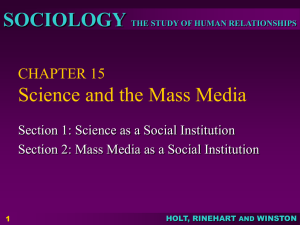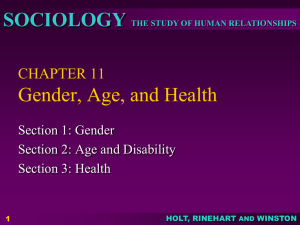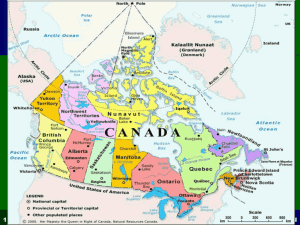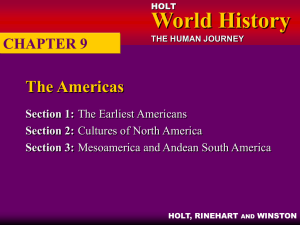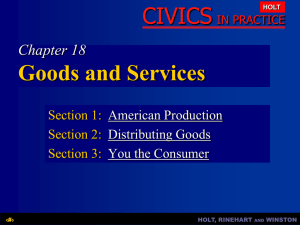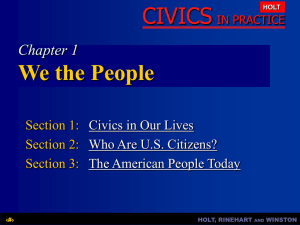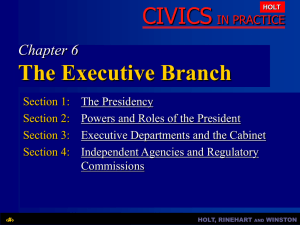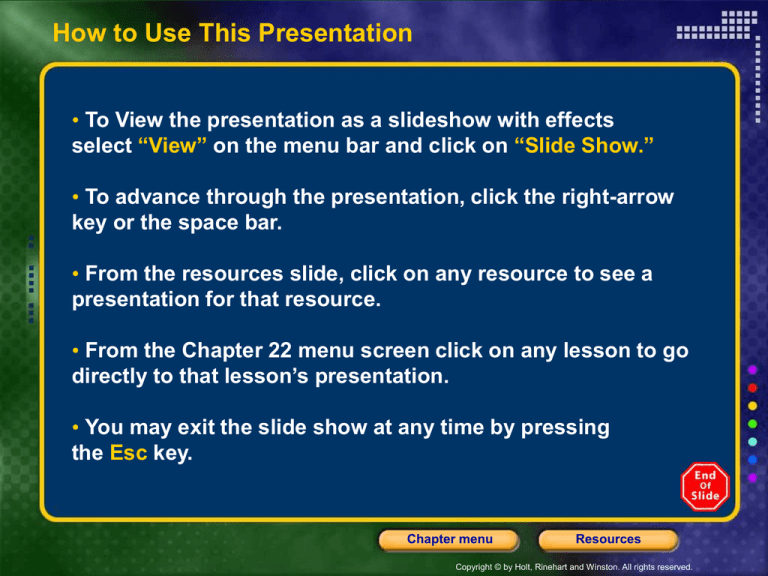
How to Use This Presentation
• To View the presentation as a slideshow with effects
select “View” on the menu bar and click on “Slide Show.”
• To advance through the presentation, click the right-arrow
key or the space bar.
• From the resources slide, click on any resource to see a
presentation for that resource.
• From the Chapter 22 menu screen click on any lesson to go
directly to that lesson’s presentation.
• You may exit the slide show at any time by pressing
the Esc key.
Chapter menu
Resources
Copyright © by Holt, Rinehart and Winston. All rights reserved.
Resources
Bellringers
Chapter Presentation
Transparencies
Standardized Test Prep
Visual Concepts
Image and Math Focus Bank
Chapter menu
Resources
Copyright © by Holt, Rinehart and Winston. All rights reserved.
Chapter 22
Exploring Space
Table of Contents
Section 1 Rocket Science
Section 2 Artificial Satellites
Section 3 Space Probes
Section 4 People in Space
Chapter menu
Resources
Copyright © by Holt, Rinehart and Winston. All rights reserved.
Chapter 22
Section 1 Rocket Science
Bellringer
Why can’t a commercial airplane be used
for space exploration?
Write and illustrate your answer in your
science journal.
Chapter menu
Resources
Copyright © by Holt, Rinehart and Winston. All rights reserved.
Chapter 22
Section 1 Rocket Science
Objectives
• Outline the development of rocket technology.
• Describe how a rocket accelerates.
• Explain the difference between orbital velocity
and escape velocity.
Chapter menu
Resources
Copyright © by Holt, Rinehart and Winston. All rights reserved.
Chapter 22
Section 1 Rocket Science
The Beginnings of Rocket Science
• About 100 years ago, Russian high school teacher
Konstantin Tsiolkovsky proposed that machines
called rockets could take people to outer space.
• A rocket is a machine that uses escaping gas from
burning fuel to move.
Chapter menu
Resources
Copyright © by Holt, Rinehart and Winston. All rights reserved.
Chapter 22
Section 1 Rocket Science
Beginnings of Rocket Science, continued
• Tsiolkovsky’s inspiration came from the stories of
Jules Verne. In Verne’s book From the Earth to the
Moon, characters reached the moon in a capsule
shot from an enormous cannon.
• Although this idea would not work, Tsiolkovsky
proved—in theory—that rockets could generate
enough force to reach outer space.
• For his vision and careful work, Tsiolkovsky is
known as the father of rocket theory.
Chapter menu
Resources
Copyright © by Holt, Rinehart and Winston. All rights reserved.
Chapter 22
Section 1 Rocket Science
Beginnings of Rocket Science, continued
• A Boost for Modern Rocketry While Tsiolkovsky
proved scientifically that rockets could reach outer
space, he never built any rockets himself.
• American physicist and inventor Robert Goddard
launched the first successful liquid-fuel rocket in 1926.
Chapter menu
Resources
Copyright © by Holt, Rinehart and Winston. All rights reserved.
Chapter 22
Section 1 Rocket Science
Beginnings of Rocket Science, continued
• Goddard tested more than 150 rocket engines, and
by the time of World War II, Goddard’s work began to
interest the Unites States military.
• Goddard’s work drew much attention because of a
terrifying new weapon that the German army had
developed.
Chapter menu
Resources
Copyright © by Holt, Rinehart and Winston. All rights reserved.
Chapter 22
Section 1 Rocket Science
From Rocket Bombs to Rocket Ships
• Toward the end of World War II, Nazi Germany
developed a new weapon known as the V-2 rocket
• The V-2 rocket could deliver explosives from
German military bases to London—a distance of
about 350 km.
• The V-2 rocket was developed by a team led by
Wernher von Braun, a young Ph.D. student whose
research was supported by the German military.
Chapter menu
Resources
Copyright © by Holt, Rinehart and Winston. All rights reserved.
Chapter 22
Section 1 Rocket Science
Rocket Bombs to Rocket Ships, continued
• In 1945, near the end of the war, von Braun and his
entire research team surrendered to the advancing
America army. The United States thus gained 127 of
the best German rocket scientists.
• With this gain, rocket research in the United States
boomed in the 1950s.
Chapter menu
Resources
Copyright © by Holt, Rinehart and Winston. All rights reserved.
Chapter 22
Section 1 Rocket Science
Rocket Bombs to Rocket Ships, continued
• The Birth of NASA The end of World War II
marked the beginning of the Cold War, a long
period of political tension between the United
States and the Soviet Union.
• The Cold War was marked by an arms race and
by competition in space technology.
Chapter menu
Resources
Copyright © by Holt, Rinehart and Winston. All rights reserved.
Chapter 22
Section 1 Rocket Science
Rocket Bombs to Rocket Ships, continued
• In response to Soviet advances in space, the U.S.
government formed the National Aeronautics and
Space Administration, or NASA, in 1958.
• NASA combined all of the rocket-development
teams in the United States. Their cooperation led to
the development of many rockets, including those
shown on the next slide.
Chapter menu
Resources
Copyright © by Holt, Rinehart and Winston. All rights reserved.
Chapter 22
Section 1 Rocket Science
Chapter menu
Resources
Copyright © by Holt, Rinehart and Winston. All rights reserved.
Chapter 22
Section 1 Rocket Science
How Rockets Work
• For Every Action . . . Newton’s third law of motion
states that for every action there is an equal and
opposite reaction.
• This can be demonstrated if you blow up a balloon
and let it go. Air rushing backward from the balloon
(the action) results in the forward motion of the
balloon (the reaction).
Chapter menu
Resources
Copyright © by Holt, Rinehart and Winston. All rights reserved.
Chapter 22
Section 1 Rocket Science
How Rockets Work, continued
• Rockets work in the same way. In fact, rockets
were once called reaction devices.
• The following slide goes into further detail as to
how rockets work.
Chapter menu
Resources
Copyright © by Holt, Rinehart and Winston. All rights reserved.
Chapter 22
Section 1 Rocket Science
Chapter menu
Resources
Copyright © by Holt, Rinehart and Winston. All rights reserved.
Chapter 22
Section 1 Rocket Science
How Rockets Work, continued
• In the case of rockets, the action and the reaction
may not be obvious.
• The mass of a rocket—including all of the fuel it
carries—is much greater than the mass of the hot
gases that come out of the bottom of the rocket.
Chapter menu
Resources
Copyright © by Holt, Rinehart and Winston. All rights reserved.
Chapter 22
Section 1 Rocket Science
How Rockets Work, continued
• Because the exhaust gases are under extreme
pressure, they exert a huge amount of force. The
force that accelerates a rocket is called thrust.
• Thrust is the pushing or pulling force exerted by
the engine of an aircraft or rocket.
Chapter menu
Resources
Copyright © by Holt, Rinehart and Winston. All rights reserved.
Chapter 22
Section 1 Rocket Science
Thrust
Click below to watch the Visual Concept.
Visual Concept
You may stop the video at any time by pressing
the Esc key.
Chapter menu
Resources
Copyright © by Holt, Rinehart and Winston. All rights reserved.
Chapter 22
Section 1 Rocket Science
How Rockets Work, continued
• You Need More Than Rocket Fuel Rockets burn
fuel to provide the thrust that propels them. In order
for something to burn, oxygen must be present.
• Although oxygen is plentiful at the Earth’s surface,
there is little or no oxygen in the upper atmosphere
and in outer space.
Chapter menu
Resources
Copyright © by Holt, Rinehart and Winston. All rights reserved.
Chapter 22
Section 1 Rocket Science
How Rockets Work, continued
• For this reason, rockets that go into outer space
must carry enough oxygen with them to be able to
burn their fuel.
• The space shuttles, for example, carry hundreds of
thousands of gallons of liquid oxygen. This oxygen is
needed to burn the shuttle’s rocket fuel.
Chapter menu
Resources
Copyright © by Holt, Rinehart and Winston. All rights reserved.
Chapter 22
Section 1 Rocket Science
How to Leave the Earth
• The gravitational pull of the Earth is the main factor
a rocket must overcome. A rocket must reach a
certain velocity, or speed and direction, to orbit or
escape the Earth.
Chapter menu
Resources
Copyright © by Holt, Rinehart and Winston. All rights reserved.
Chapter 22
Section 1 Rocket Science
How to Leave the Earth, continued
• Orbital Velocity and Escape Velocity For a rocket
to orbit the Earth, it must have enough thrust to reach
orbital velocity.
• Orbital velocity is the speed and direction a rocket
must travel in order to orbit a planet or moon.
• The lowest possible speed a rocket may go and still
orbit the Earth is about 8 km/s (17,927 mi/h). If the
rocket goes any slower, it will fall back to Earth.
Chapter menu
Resources
Copyright © by Holt, Rinehart and Winston. All rights reserved.
Chapter 22
Section 1 Rocket Science
How to Leave the Earth, continued
• For a rocket to travel beyond Earth orbit, the rocket
must achieve escape velocity.
• Escape velocity is the speed and direction a rocket
must travel to completely break away from a planet’s
gravitational pull.
• The speed a rocket must reach to escape the Earth
is about 11 km/s (24,606 mi/h).
Chapter menu
Resources
Copyright © by Holt, Rinehart and Winston. All rights reserved.
Chapter 22
Section 1 Rocket Science
Orbital, Suborbital, and Escape Velocities
Click below to watch the Visual Concept.
Visual Concept
You may stop the video at any time by pressing
the Esc key.
Chapter menu
Resources
Copyright © by Holt, Rinehart and Winston. All rights reserved.
Chapter 22
Section 2 Artificial Satellites
Bellringer
Write two paragraphs describing the ways in
which satellite technology affects your life.
Write your answers in your science journal.
Chapter menu
Resources
Copyright © by Holt, Rinehart and Winston. All rights reserved.
Chapter 22
Section 2 Artificial Satellites
Objectives
• Identify the first satellites.
• Compare low Earth orbits with geostationary orbits.
• Explain the functions of military, communications,
and weather satellites.
• Explain how remote sensing from satellites has
helped us study Earth as a global system.
Chapter menu
Resources
Copyright © by Holt, Rinehart and Winston. All rights reserved.
Chapter 22
Section 2 Artificial Satellites
The First Satellites
• An artificial satellite is any human-made object
placed in orbit around a body in space.
• There are many kinds of artificial satellites, including
weather satellites, communications satellites, and
remote-sensing satellites.
Chapter menu
Resources
Copyright © by Holt, Rinehart and Winston. All rights reserved.
Chapter 22
Section 2 Artificial Satellites
The First Satellites, continued
• In 1957, the Soviets launched the first artificial
satellite, Sputnik 1. It orbited for 57 days before it
fell back to Earth and burned up in the atmosphere.
• Two months later, Sputnik 2 carried the first living
being into space—a dog named Laika.
Chapter menu
Resources
Copyright © by Holt, Rinehart and Winston. All rights reserved.
Chapter 22
Section 2 Artificial Satellites
The First Satellites, continued
• The United States launched its first satellite,
Explorer 1, in 1958.
• The development of new satellites increased
quickly. By 1964, communications satellite
networks were able to send messages around
the world.
• Today, thousands of satellites orbit the Earth,
and more are launched every year.
Chapter menu
Resources
Copyright © by Holt, Rinehart and Winston. All rights reserved.
Chapter 22
Section 2 Artificial Satellites
Choosing Your Orbit
• Satellites are placed in different types of orbits. All
of the early satellites were placed in low Earth orbit.
• Low Earth orbit (LEO) is an orbit less than 1,500
km above the Earth’s surface.
• A satellite in LEO moves around the Earth very
quickly and can provide clear images of the Earth.
However, this motion can place a satellite out of
contact much of the time.
Chapter menu
Resources
Copyright © by Holt, Rinehart and Winston. All rights reserved.
Chapter 22
Section 2 Artificial Satellites
Choosing Your Orbit, continued
• Most communications and weather satellites circle
the Earth in geostationary orbit.
• Geostationary orbit (GEO) is an orbit that is about
36,000 km above the Earth’s surface and in which a
satellite is above a fixed spot on the equator.
• A satellite in GEO is always above the same spot
on Earth. Ground stations are in continuous contact
with these satellites so that communications will not
be interrupted.
Chapter menu
Resources
Copyright © by Holt, Rinehart and Winston. All rights reserved.
Chapter 22
Section 2 Artificial Satellites
Chapter menu
Resources
Copyright © by Holt, Rinehart and Winston. All rights reserved.
Chapter 22
Section 2 Artificial Satellites
Military Satellites
• Some satellites placed in LEO are equipped with
cameras that can photograph the Earth’s surface in
amazing detail. It is possible to photograph objects
as small as a book from LEO.
• While satellite photographs are now used for
everything from developing real estate to tracking
movements of dolphins, the technology was first
developed by the military.
Chapter menu
Resources
Copyright © by Holt, Rinehart and Winston. All rights reserved.
Chapter 22
Section 2 Artificial Satellites
Military Satellites, continued
• Because satellites can take very detailed photos
from hundreds of kilometers above the Earth’s
surface, they are ideal for defense purposes.
• The United States and the Soviet Union developed
satellites to spy on each other right up to the end of
the Cold War.
• Even though the Cold War is over, spy satellites
continue to play an important role in the military
defense of many countries.
Chapter menu
Resources
Copyright © by Holt, Rinehart and Winston. All rights reserved.
Chapter 22
Section 2 Artificial Satellites
Military Satellites, continued
• The Global Positioning System In the past,
people invented very complicated ways to keep
from getting lost.
• Now, for less than $100, people can determine their
exact location on Earth by using a Global Positioning
System (GPS) receiver.
• GPS is another example of military satellite technology that has become a part of everyday life.
Chapter menu
Resources
Copyright © by Holt, Rinehart and Winston. All rights reserved.
Chapter 22
Section 2 Artificial Satellites
Military Satellites, continued
• The GPS consists of 27 solar-powered satellites
that continuously send radio signals to Earth.
• From the amount of time it takes the signals to
reach Earth, the hand-held receiver can calculate
its distance from the satellites.
• Using the distance from three or four satellites, a
GPS receiver can determine a person’s location
with great accuracy.
Chapter menu
Resources
Copyright © by Holt, Rinehart and Winston. All rights reserved.
Chapter 22
Section 2 Artificial Satellites
Global Positioning System (GPS)
Click below to watch the Visual Concept.
Visual Concept
You may stop the video at any time by pressing
the Esc key.
Chapter menu
Resources
Copyright © by Holt, Rinehart and Winston. All rights reserved.
Chapter 22
Section 2 Artificial Satellites
Weather Satellites
• Every day, millions of people make decisions based
on information provided by weather satellites.
• Weather satellites in GEO provide a big-picture
view of the Earth’s atmosphere. These satellites
constantly monitor the atmosphere for the “triggers”
that lead to severe weather conditions.
Chapter menu
Resources
Copyright © by Holt, Rinehart and Winston. All rights reserved.
Chapter 22
Section 2 Artificial Satellites
Weather Satellites, continued
• Weather satellites in LEO are usually placed in
polar orbits. Satellites in polar orbits revolve around
the Earth in a north or south direction as the Earth
rotates beneath them.
• These satellites, which orbit between 830 km and
870 km above the Earth, provide a much closer look
at weather patterns.
Chapter menu
Resources
Copyright © by Holt, Rinehart and Winston. All rights reserved.
Chapter 22
Section 2 Artificial Satellites
Communications Satellites
• Many types of modern communications use radio
waves or microwaves to relay messages. Radio
waves and microwaves are ideal for communications
because they can travel through the air.
• The problem is that the Earth is round, but the
waves travel in a straight line.
Chapter menu
Resources
Copyright © by Holt, Rinehart and Winston. All rights reserved.
Chapter 22
Section 2 Artificial Satellites
Communications Satellites, continued
• Communications satellites in GEO solve this
problem by relaying information from one point on
Earth’s surface to another.
• The signals are transmitted to a satellite and then
sent to receivers around the world.
• Communications satellites relay computer data, and
some television and radio broadcasts.
Chapter menu
Resources
Copyright © by Holt, Rinehart and Winston. All rights reserved.
Chapter 22
Section 2 Artificial Satellites
Remote Sensing and Environmental Change
• Satellites gather information by remote sensing.
Remote sensing is the gathering of images and
data from a distance.
• Remote sensing satellites measure light and other
forms of energy that are reflected from Earth.
• Some satellites use radar, which bounces highfrequency radio waves off the Earth and measure
the returned signal.
Chapter menu
Resources
Copyright © by Holt, Rinehart and Winston. All rights reserved.
Chapter 22
Section 2 Artificial Satellites
Remote Sensing, continued
• Landsat: Monitoring the Earth from Orbit One of
the most successful remote-sensing projects is the
Landsat program, which began in 1972 and continues
today.
• Landsat satellites gather images in several different
wavelengths—from visible light to infrared.
• The next slide shows two Landsat images of the
Mississippi Delta.
Chapter menu
Resources
Copyright © by Holt, Rinehart and Winston. All rights reserved.
Chapter 22
Section 2 Artificial Satellites
Chapter menu
Resources
Copyright © by Holt, Rinehart and Winston. All rights reserved.
Chapter 22
Section 2 Artificial Satellites
Remote Sensing, continued
• One image was taken in 1973, and the other was
taken in 2003. The two images reveal a pattern of
environmental change over a 30-year period.
• The main change is a dramatic reduction in the
amount of silt that is reaching the delta. A comparison
of the images also reveals a large-scale loss of
wetlands in the bottom left of the delta in 2003.
Chapter menu
Resources
Copyright © by Holt, Rinehart and Winston. All rights reserved.
Chapter 22
Section 2 Artificial Satellites
Remote Sensing, continued
• A New Generation of Remote-Sensing Satellites
The Landsat program has produced millions of images
that are used to identify and track environmental
changes on Earth.
• Satellite remote sensing allows scientists to perform
large-scale mapping, look at changes in patterns of
vegetation growth, map the spread of urban development, and study the effect of humans on the global
environment.
Chapter menu
Resources
Copyright © by Holt, Rinehart and Winston. All rights reserved.
Chapter 22
Section 2 Artificial Satellites
Remote Sensing, continued
• In 1999, NASA launched Terra 1, the first satellite in
NASA’s Earth Observing System (EOS) program.
• Satellites in the EOS program are designed to work
together so that they can gather integrated data on
environmental change on the land, in the oceans, in
the atmosphere, and on the icecaps.
Chapter menu
Resources
Copyright © by Holt, Rinehart and Winston. All rights reserved.
Chapter 22
Section 3 Space Probes
Bellringer
Does exploring other planets benefit us here on
Earth? Why or why not?
Write your response in your science journal.
Chapter menu
Resources
Copyright © by Holt, Rinehart and Winston. All rights reserved.
Chapter 22
Section 3 Space Probes
Objectives
• Describe five discoveries made by space probes.
• Explain how space-probe missions help us better
understand the Earth.
• Describe how NASA’s new strategy of “faster,
cheaper, and better” relates to space probes.
Chapter menu
Resources
Copyright © by Holt, Rinehart and Winston. All rights reserved.
Chapter 22
Section 3 Space Probes
Visits to the Inner Solar System
• A space probe is an uncrewed vehicle that carries
scientific instruments to planets or other bodies in
space. Scientists have launched several space
probes to explore the solar system.
• Unlike satellites, which stay in Earth orbit, space
probes travel away from the Earth.
Chapter menu
Resources
Copyright © by Holt, Rinehart and Winston. All rights reserved.
Chapter 22
Section 3 Space Probes
Visits to the Inner Solar System, continued
• Space probes are valuable because they can
complete missions that would be very dangerous
and expensive for humans to undertake.
• Because Earth’s moon and the inner planets are
much closer than the other planets and moons in
the solar system, they were the first to be explored
by space probes.
Chapter menu
Resources
Copyright © by Holt, Rinehart and Winston. All rights reserved.
Chapter 22
Section 3 Space Probes
Visits to the Inner Solar System, continued
• Luna and Clementine: Missions to the Moon
The first space probe, Luna 1, was launched by the
Soviets in 1959 to fly past the moon.
• In 1966, Luna 9
made the first soft
landing on the
moon’s surface.
Chapter menu
Resources
Copyright © by Holt, Rinehart and Winston. All rights reserved.
Chapter 22
Section 3 Space Probes
Visits to the Inner Solar System, continued
• During the next 10 years, the United States and the
Soviet Union completed more than 30 lunar missions.
• Thousands of images of the moon’s surface were
taken.
Chapter menu
Resources
Copyright © by Holt, Rinehart and Winston. All rights reserved.
Chapter 22
Section 3 Space Probes
Visits to the Inner Solar System, continued
• In 1994, the U.S. probe Clementine discovered that
craters of the moon may contain water left by comet
impacts.
• In 1998, the Lunar Prospector confirmed that frozen
water exists on the moon.
Chapter menu
Resources
Copyright © by Holt, Rinehart and Winston. All rights reserved.
Chapter 22
Section 3 Space Probes
Visits to the Inner Solar System, continued
• Venera 9: The First Probe to Land on Venus
Launched in 1975, the
Soviet probe Venera 9
parachuted into Venus’s
atmosphere and transmitted images of the
surface to Earth.
• Venera 9 found that the surface temperature of
Venus is an average of 464°C—hot enough to
melt lead.
Chapter menu
Resources
Copyright © by Holt, Rinehart and Winston. All rights reserved.
Chapter 22
Section 3 Space Probes
Visits to the Inner Solar System, continued
• Venera 9 also found that the chemistry of surface
rocks on Venus is similar to that of Earth rocks.
• Perhaps most important, Venera 9 and earlier
missions revealed that Venus has a severe
greenhouse effect.
• Scientists study Venus’s atmosphere to learn about
the effects of increased greenhouse gases in Earth’s
atmosphere.
Chapter menu
Resources
Copyright © by Holt, Rinehart and Winston. All rights reserved.
Chapter 22
Section 3 Space Probes
Visits to the Inner Solar System, continued
• The Magellan Mission: Mapping Venus In 1989,
the United States launched the Magellan probe, which
used radar to map 98% of the surface of Venus.
• The radar data were
transmitted back to Earth
where computers used the
data to generate threedimensional images.
Chapter menu
Resources
Copyright © by Holt, Rinehart and Winston. All rights reserved.
Chapter 22
Section 3 Space Probes
Visits to the Inner Solar System, continued
• The Magellan mission showed that, in many ways,
the geology of Venus is similar to that of Earth.
• Venus has features that suggest plate tectonics
occurs there, as it does on Earth.
• Venus also has volcanoes, and some of them may
be active.
Chapter menu
Resources
Copyright © by Holt, Rinehart and Winston. All rights reserved.
Chapter 22
Section 3 Space Probes
Visits to the Inner Solar System, continued
• The Viking Missions: Exploring Mars In 1975, the
United States sent a pair of probes—Viking 1 and
Viking 2—to Mars.
• The surface of Mars is
more like Earth’s surface
than that of any other
planet. For this reason,
one of the main goals of
the Viking missions was to
look for signs of life.
Chapter menu
Resources
Copyright © by Holt, Rinehart and Winston. All rights reserved.
Chapter 22
Section 3 Space Probes
Visits to the Inner Solar System, continued
• The Viking probes contained instruments designed
to gather soil and test it for evidence of life. However,
no hard evidence was found.
• The Viking missions did find evidence that Mars was
once much warmer and wetter than it is now.
• This discovery led scientists to ask even more
questions about Mars.
Chapter menu
Resources
Copyright © by Holt, Rinehart and Winston. All rights reserved.
Chapter 22
Section 3 Space Probes
Visits to the Inner Solar System, continued
• The Mars Pathfinder Mission: Revisiting Mars
In 1997, the surface of Mars was visited again by a
NASA probe.
• The goal of the Mars
Pathfinder mission was
to show that Martian
exploration is possible at
a much lower cost than
the Viking missions.
Chapter menu
Resources
Copyright © by Holt, Rinehart and Winston. All rights reserved.
Chapter 22
Section 3 Space Probes
Visits to the Inner Solar System, continued
• The Mars Pathfinder sent back detailed images of
dry water channels on Mars. These images suggest
that massive floods flowed across the surface of Mars
relatively recently in the planet’s past.
• Once the probe landed on Mars, it deployed the
Sojourner rover. Sojourner traveled across the surface
of Mars for almost three months, collecting data and
recording images.
Chapter menu
Resources
Copyright © by Holt, Rinehart and Winston. All rights reserved.
Chapter 22
Section 3 Space Probes
Visits to the Inner Solar System, continued
• Two more NASA probes have recently landed on
Mars and have deployed rovers. Other Martian
missions are planned for the near future.
• These missions will pave the way for a crewed
mission to Mars that may occur in your lifetime.
Chapter menu
Resources
Copyright © by Holt, Rinehart and Winston. All rights reserved.
Chapter 22
Section 3 Space Probes
Visits to the Outer Solar System
• The planets in the outer solar system—Jupiter,
Saturn, Uranus, Neptune, and Pluto—are very far
away.
• It can take probes 10 years or more to complete
their missions to the outer planets.
Chapter menu
Resources
Copyright © by Holt, Rinehart and Winston. All rights reserved.
Chapter 22
Section 3 Space Probes
Visits to the Outer Solar System, continued
• Pioneer and Voyager: To Jupiter and Beyond
The Pioneer 10 and Pioneer 11 space probes were
the first to visit the outer planets.
• Among other things,
these probes sampled
the solar wind, the flow
of particles coming
from the sun.
Chapter menu
Resources
Copyright © by Holt, Rinehart and Winston. All rights reserved.
Chapter 22
Section 3 Space Probes
Visits to the Outer Solar System, continued
• The Pioneer probes also found that the dark belts
on Jupiter provide deep views into Jupiter’s
atmosphere.
• In 1983, Pioneer 10 became the first probe to travel
past the orbit of Pluto, the outermost planet.
Chapter menu
Resources
Copyright © by Holt, Rinehart and Winston. All rights reserved.
Chapter 22
Section 3 Space Probes
Visits to the Outer Solar System, continued
• The Voyager probes were the first to detect the faint
rings around Jupiter, and Voyager 2 was the first
probe to fly by the four gas giants—Jupiter, Saturn,
Uranus, and Neptune.
• The paths of the Pioneer and Voyager space probes
are shown on the next slide. Today, they are near the
solar system’s edge and some are still sending back
data.
Chapter menu
Resources
Copyright © by Holt, Rinehart and Winston. All rights reserved.
Chapter 22
Section 3 Space Probes
Chapter menu
Resources
Copyright © by Holt, Rinehart and Winston. All rights reserved.
Chapter 22
Section 3 Space Probes
Visits to the Outer Solar System, continued
• The Galileo Mission: A Return to Jupiter In 1995,
the Galileo probe arrived at Jupiter.
• While Galileo began a tour
of Jupiter’s moons, it sent a
smaller probe into Jupiter’s
atmosphere to measure its
composition, temperature,
density, and cloud structure.
Chapter menu
Resources
Copyright © by Holt, Rinehart and Winston. All rights reserved.
Chapter 22
Section 3 Space Probes
Visits to the Outer Solar System, continued
• Galileo gathered data about the geology of Jupiter’s
major moons and Jupiter’s magnetic properties.
• The moons of Jupiter proved to be far more exciting
than the earlier Pioneer and Voyager images had
suggested.
• Galileo found that two moons have magnetic fields.
The probe also discovered that the moon Europa may
have an ocean of liquid water under its icy surface.
Chapter menu
Resources
Copyright © by Holt, Rinehart and Winston. All rights reserved.
Chapter 22
Section 3 Space Probes
Visits to the Outer Solar System, continued
• The Cassini Mission: Exploring Saturn’s Moons
In 1997, the Cassini space probe was launched on a
seven-year journey to Saturn where it will make a
grand tour of Saturn’s moons.
• A smaller probe, the Huygens probe, will detach
from Cassini and descend into the atmosphere of
Saturn’s moon Titan. Scientists are interested in
Titan’s atmosphere because it may be similar to
Earth’s early atmosphere.
Chapter menu
Resources
Copyright © by Holt, Rinehart and Winston. All rights reserved.
Chapter 22
Section 3 Space Probes
Faster, Cheaper, and Better
• The early space probe missions were very large and
costly, and took years to develop. Now, NASA’s vision
is for missions that are “faster, cheaper, and better.”
• One new program, Discovery, seeks proposals for
smaller science programs.
• The first six approved Discovery missions include
sending small space probes to asteroids, landing on
Mars again, studying the moon, and returning comet
dust to Earth.
Chapter menu
Resources
Copyright © by Holt, Rinehart and Winston. All rights reserved.
Chapter 22
Section 3 Space Probes
Faster, Cheaper, and Better, continued
• Stardust: Comet Detective Launched in 1999, the
Stardust space probe is the first probe to focus only
on a comet.
• The probe will arrive at the comet in 2004 and gather
samples of the comet’s dust tail. It will return samples
to Earth in 2006.
• For the first time, pure samples from beyond the
orbit of the moon will be brought back to Earth.
Chapter menu
Resources
Copyright © by Holt, Rinehart and Winston. All rights reserved.
Chapter 22
Section 3 Space Probes
Faster, Cheaper, and Better, continued
• Deep Space 1: Testing Ion Propulsion Another
NASA project is the New Millennium program. The
program’s purpose is to test new technologies that
can be used in the future.
• Deep Space 1 is the first mission of this program. It
is a space probe with an ion-propulsion system.
• Instead of burning chemical fuel, an ion rocket uses
charged particles that exit the vehicle at high speed.
Chapter menu
Resources
Copyright © by Holt, Rinehart and Winston. All rights reserved.
Chapter 22
Section 4 People in Space
Bellringer
Write a letter from a space station orbiting Earth.
Describe the station, your mission, and your
day-to-day life aboard the space station.
Write your letter in your science journal.
Chapter menu
Resources
Copyright © by Holt, Rinehart and Winston. All rights reserved.
Chapter 22
Section 4 People in Space
Objectives
• Summarize the history and future of human
spaceflight.
• Explain the benefits of crewed space programs.
• Identify five “space-age spinoffs” that are used
in everyday life.
Chapter menu
Resources
Copyright © by Holt, Rinehart and Winston. All rights reserved.
Chapter 22
Section 4 People in Space
The Race Is On
• In 1961, Yuri Gargarin became the first human to orbit
Earth. The Soviets were the first once again, and the
Americans were concerned that their rivals were
winning the space race.
• One month after Gargarin’s flight, President John F.
Kennedy announced that the United States should
commit itself to landing a man on the moon
• In 1962, John Glenn became the first American to
orbit the Earth.
Chapter menu
Resources
Copyright © by Holt, Rinehart and Winston. All rights reserved.
Chapter 22
Section 4 People in Space
The Race Is On, continued
• “The Eagle Has Landed” Kennedy’s challenge was
met on July 20, 1969. The world watched on television
as the Apollo 11 landing module, the Eagle, landed on
the moon.
• Neil Armstrong became the first human to set foot on
a world other than Earth.
Chapter menu
Resources
Copyright © by Holt, Rinehart and Winston. All rights reserved.
Chapter 22
Section 4 People in Space
The Race Is On, continued
• The moon landing forever changed the way we view
ourselves and our planet. The Apollo missions also
contributed to the advancement of science.
• Apollo 11 returned moon rocks to the Earth for study.
Its crew also put devices on the moon to study moonquakes and the solar wind.
Chapter menu
Resources
Copyright © by Holt, Rinehart and Winston. All rights reserved.
Chapter 22
Section 4 People in Space
Reusable Space Vehicles
• The Saturn V rockets that carried Apollo astronauts
to the moon were huge and very expensive. They
were longer than a football field, and each could be
used only once.
• To save money, NASA began to develop the space
shuttle program in 1972.
• A space shuttle is a reusable space vehicle that
takes off like a rocket and lands like an airplane.
Chapter menu
Resources
Copyright © by Holt, Rinehart and Winston. All rights reserved.
Chapter 22
Section 4 People in Space
Reusable Space Vehicles, continued
• The Space Shuttle Gets off the Ground Columbia,
the first space shuttle, was launched in 1981. Since
then, NASA has completed more than 100 successful
shuttle missions.
• The shuttle orbiter is about the size of an airplane. It
caries the astronauts and payload into space. After
completing a mission, the orbiter returns to Earth and
lands like an airplane.
Chapter menu
Resources
Copyright © by Holt, Rinehart and Winston. All rights reserved.
Chapter 22
Section 4 People in Space
Reusable Space Vehicles, continued
• The shuttle also consists of a large liquid-fuel tank
and two solid-fuel booster rockets that help the shuttle
reach orbit.
• Once the shuttle reaches orbit, the booster rockets
and the fuel tank fall back to Earth. The boosters are
reused, but the fuel tank is not.
Chapter menu
Resources
Copyright © by Holt, Rinehart and Winston. All rights reserved.
Chapter 22
Section 4 People in Space
Reusable Space Vehicles, continued
• Shuttle Tragedies In 1986, a booster rocket on the
space shuttle Challenger exploded just after takeoff,
killing all seven of its astronauts.
• Investigations found that cold weather on the morning
of the launch had caused rubber gaskets in the solid
fuel booster rockets to stiffen and fail, resulting in an
explosion.
• The shuttle program resumed in 1988.
Chapter menu
Resources
Copyright © by Holt, Rinehart and Winston. All rights reserved.
Chapter 22
Section 4 People in Space
Reusable Space Vehicles, continued
• In 2003, the space shuttle Columbia exploded as it
reentered the atmosphere. All seven astronauts on
board were killed.
• These disasters emphasize the dangers of space
exploration that continue to challenge scientists and
engineers.
Chapter menu
Resources
Copyright © by Holt, Rinehart and Winston. All rights reserved.
Chapter 22
Section 4 People in Space
Reusable Space Vehicles, continued
• SpaceShipOne: Private Spacecraft In 2004,
SpaceShipOne won the $10 million X Prize!
• The X Prize was offered for the first privately owned,
reusable vehicle that could carry a crew to an altitude
of at least 100 km. The X Prize was offered to
encourage the development of space technology in
the private sector.
Chapter menu
Resources
Copyright © by Holt, Rinehart and Winston. All rights reserved.
Chapter 22
Section 4 People in Space
Space Stations—People Working in Space
• A space station is a long-term orbiting platform in
space from which other vehicles can be launched or
scientific research can be carried out.
• In 1971, the Soviets became the first to successfully
place a space station in orbit. A crew of three Soviet
cosmonauts conducted a 23-day mission aboard the
station, which was called Salyut 1.
Chapter menu
Resources
Copyright © by Holt, Rinehart and Winston. All rights reserved.
Chapter 22
Section 4 People in Space
Space Stations, continued
• By 1982, the Soviets had put up seven space stations.
Because of this experience, the Soviet Union became a
leader in space-station development and in the study of
the effects of weightlessness on humans.
• Their discoveries will be important for future flights to
other planets -- journeys that will take years in space to
complete.
Chapter menu
Resources
Copyright © by Holt, Rinehart and Winston. All rights reserved.
Chapter 22
Section 4 People in Space
Space Station
Click below to watch the Visual Concept.
Visual Concept
You may stop the video at any time by pressing
the Esc key.
Chapter menu
Resources
Copyright © by Holt, Rinehart and Winston. All rights reserved.
Chapter 22
Section 4 People in Space
Space Stations, continued
• Skylab and Mir The first U.S. space station was
Skylab, a science and engineering lab used to conduct
a wide variety of scientific studies.
• These studies included experiments in biology and
space manufacturing, and astronomical observations.
• Three different crews spent a total of 171 days on
Skylab before it was abandoned.
Chapter menu
Resources
Copyright © by Holt, Rinehart and Winston. All rights reserved.
Chapter 22
Section 4 People in Space
Space Stations, continued
• In 1986, the Soviets began to launch the pieces for a
much more ambitious space station called Mir, which
means “peace.”
• Cosmonauts on the Mir station conducted a wide
range of experiments, made many astronomical
observations, and studied manufacturing in space.
• After 15 years, Mir was abandoned and it burned up in
the Earth’s atmosphere in 2001.
Chapter menu
Resources
Copyright © by Holt, Rinehart and Winston. All rights reserved.
Chapter 22
Section 4 People in Space
The International Space Station
• The International Space Station (ISS), the newest
space station, is being constructed in LEO. Russia,
the United States, and 14 other countries are
designing and building different parts of the station.
• When completed, the ISS will be about the size of a
soccer field and will weigh about 800 tons.
• The ISS is being built with materials brought up on
the space shuttles and by Russian rockets.
Chapter menu
Resources
Copyright © by Holt, Rinehart and Winston. All rights reserved.
Chapter 22
Section 4 People in Space
International Space Station, continued
• The United States is providing lab modules, living
quarters, the supporting frame, solar panels, and a
biomedical laboratory.
• The Russians are contributing a service module,
docking modules, life support and research modules,
and transportation to and from the station.
• Construction on ISS began in 1998 and should be
complete by 2010.
Chapter menu
Resources
Copyright © by Holt, Rinehart and Winston. All rights reserved.
Chapter 22
Section 4 People in Space
International Space Station, continued
• Research on the International Space Station
The ISS will provide many benefits, some of which
we cannot predict.
• Scientists do know is that it will be a unique, spacebased facility to perform space-science experiments
and to test new technologies.
Chapter menu
Resources
Copyright © by Holt, Rinehart and Winston. All rights reserved.
Chapter 22
Section 4 People in Space
International Space Station, continued
• Much of the space race involved political and military
rivalry between the Soviet Union and the United States.
• Hopefully, the ISS will promote cooperation between
countries while continuing the pioneering spirit of the
first astronauts and cosmonauts.
Chapter menu
Resources
Copyright © by Holt, Rinehart and Winston. All rights reserved.
Chapter 22
Section 4 People in Space
To the Moon, Mars, and Beyond
• We may eventually need resources beyond what the
Earth can offer. Space offers many such resources.
• The moon will be an important part of further study
and exploration of the solar system.
• For example, the far side of the moon can be 100
times as dark as any observatory site on Earth.
Chapter menu
Resources
Copyright © by Holt, Rinehart and Winston. All rights reserved.
Chapter 22
Section 4 People in Space
To the Moon, Mars, and Beyond, continued
• A base on the moon could be used to manufacture
materials in low gravity or in a vacuum.
• A colony on the moon or on Mars could be an
important link to bringing space resources to Earth.
• The key will be to make sure that space missions are
economically worthwhile.
Chapter menu
Resources
Copyright © by Holt, Rinehart and Winston. All rights reserved.
Chapter 22
Section 4 People in Space
The Benefits of the Space Program
• Why should we continue to explore space?
• When exploring space, scientists not only learn more
about space itself, but they also gain a large amount of
knowledge from developing the missions to space.
• The information gained by developing these missions
can be used to make our everyday lives better.
Chapter menu
Resources
Copyright © by Holt, Rinehart and Winston. All rights reserved.
Chapter 22
Section 4 People in Space
Benefits of the Space Program, continued
• Space missions required the development of new
pumps. Later, this pump technology enabled scientists
to develop artificial hearts.
• Computerized processes originally developed to help
manage launch preparations for the space shuttle are
now used in businesses all over the world.
Chapter menu
Resources
Copyright © by Holt, Rinehart and Winston. All rights reserved.
Chapter 22
Section 4 People in Space
Benefits of the Space Program, continued
• Space-Age Spinoffs Technologies developed for the
space programs that are now used in everyday life are
called space-age spinoffs.
• Cordless power tools, were first developed for use on
the moon by the Apollo astronauts.
• Hand-held cameras that were developed to study the
heat emitted from the space shuttle are now used by
firefighters to detect dangerous hot spots in fires.
Chapter menu
Resources
Copyright © by Holt, Rinehart and Winston. All rights reserved.
Chapter 22
Section 4 People in Space
Benefits of the Space Program, continued
• Spinoffs in Health and Medicine The pacemaker,
a small device inserted into a patient’s body to help
regulate heart rate, uses wireless technology that was
developed by NASA.
• The ear thermometer used to measure a person’s
body temperature relies on a special lens that detects
infrared energy, which we feel as heat.
• That type of lens was originally developed to detect
the birth of stars in space.
Chapter menu
Resources
Copyright © by Holt, Rinehart and Winston. All rights reserved.
Chapter 22
Section 4 People in Space
Benefits of the Space Program, continued
• Space-Age Materials Several types of materials
that we use every day were originally designed for use
in space.
• Heat-resistant suits used by firefighters and others
are made from chemically treated fabric.
• The chemicals were originally developed to treat
fabrics for use in spacesuits and inside spacecraft.
Chapter menu
Resources
Copyright © by Holt, Rinehart and Winston. All rights reserved.
Chapter 22
Section 4 People in Space
Benefits of the Space Program, continued
• Material developed by NASA for aircraft passenger
seats is now used in shock-absorbing helmets and
shin guards.
• Space technology is also responsible for the scratchresistant lenses that are used in eyeglasses.
Chapter menu
Resources
Copyright © by Holt, Rinehart and Winston. All rights reserved.
Chapter 22
Section 4 People in Space
Benefits of the Space Program, continued
• Transportation and Safety Spinoffs Safer bridges,
improved automobile designs, and storm-warning
devices have come from spinoff technology.
• Smoke detectors were originally used on Skylab to
detect toxic vapors.
Chapter menu
Resources
Copyright © by Holt, Rinehart and Winston. All rights reserved.
Chapter 22
Section 4 People in Space
Benefits of the Space Program, continued
• Material developed for the Viking Lander parachute
shroud is 5 times as strong as steel and has been
used to make tires. These tires are very tough and
work well in bad weather.
• Three types of NASA-developed technology are
used to design and test school buses.
• With this new technology, manufacturers are able to
test new school bus designs for safety before even
making the school bus.
Chapter menu
Resources
Copyright © by Holt, Rinehart and Winston. All rights reserved.
Chapter 22
Exploring Space
Concept Map
Use the terms below to complete the concept map on
the next slide.
thrust
space stations
gravity
low Earth orbit
artificial satellites
rockets
geostationary orbit
Newton’s third law of motion
Chapter menu
Resources
Copyright © by Holt, Rinehart and Winston. All rights reserved.
Chapter 22
Exploring Space
Chapter menu
Resources
Copyright © by Holt, Rinehart and Winston. All rights reserved.
Chapter 22
Exploring Space
Chapter menu
Resources
Copyright © by Holt, Rinehart and Winston. All rights reserved.
End of Chapter 22 Show
Chapter menu
Resources
Copyright © by Holt, Rinehart and Winston. All rights reserved.
Chapter 22
Standardized Test Preparation
Reading
Read each of the passages. Then, answer the questions
that follow the passage.
Chapter menu
Resources
Copyright © by Holt, Rinehart and Winston. All rights reserved.
Chapter 22
Standardized Test Preparation
Passage 1 One of the strange things about living in
space is free fall, the reduced effect of gravity.
Everything inside the International Space Station that
is not fastened down will float! The engineers who
designed the space station have come up with some
intriguing solutions to this problem. For example, each
astronaut sleeps in a sack similar to a sleeping bag
that is fastened to the module. The sack keeps the
astronauts from floating around while they sleep.
Continued on the next slide
Chapter menu
Resources
Copyright © by Holt, Rinehart and Winston. All rights reserved.
Chapter 22
Standardized Test Preparation
Passage 1, continued Astronauts shower with a
hand-held nozzle. Afterward, the water droplets are
vacuumed up. Other problems that are being studied
include how to prepare and serve food, how to design
an effective toilet, and how to dispose of waste.
Chapter menu
Resources
Copyright © by Holt, Rinehart and Winston. All rights reserved.
Chapter 22
Standardized Test Preparation
1. What is the main idea of the passage?
A There is no gravity in space.
B Astronauts will stay aboard the space station for
long periods of time.
C Living in free fall presents interesting problems.
D Sleeping bags are needed to keep astronauts
warm in space.
Chapter menu
Resources
Copyright © by Holt, Rinehart and Winston. All rights reserved.
Chapter 22
Standardized Test Preparation
1. What is the main idea of the passage?
A There is no gravity in space.
B Astronauts will stay aboard the space station for
long periods of time.
C Living in free fall presents interesting problems.
D Sleeping bags are needed to keep astronauts
warm in space.
Chapter menu
Resources
Copyright © by Holt, Rinehart and Winston. All rights reserved.
Chapter 22
Standardized Test Preparation
2. Which of the following is a problem mentioned in
the passage?
F how to dissipate the heat of reentry
G how to maintain air pressure
H how to serve food
I how to listen to music
Chapter menu
Resources
Copyright © by Holt, Rinehart and Winston. All rights reserved.
Chapter 22
Standardized Test Preparation
2. Which of the following is a problem mentioned in
the passage?
F how to dissipate the heat of reentry
G how to maintain air pressure
H how to serve food
I how to listen to music
Chapter menu
Resources
Copyright © by Holt, Rinehart and Winston. All rights reserved.
Chapter 22
Standardized Test Preparation
3. Which of the following words is the best
antonym for intriguing?
A authentic
B boring
C interesting
D unsolvable
Chapter menu
Resources
Copyright © by Holt, Rinehart and Winston. All rights reserved.
Chapter 22
Standardized Test Preparation
3. Which of the following words is the best
antonym for intriguing?
A authentic
B boring
C interesting
D unsolvable
Chapter menu
Resources
Copyright © by Holt, Rinehart and Winston. All rights reserved.
Chapter 22
Standardized Test Preparation
Passage 2 In 1999, the crew of the space station Mir
tried to place a large, umbrella-like mirror in orbit. The
mirror was designed to reflect sunlight to Siberia. The
experiment failed because the crew was unable to
unfold the mirror. If things had gone as planned, the
beam of reflected sunlight would have been 5 to 10
times brighter than the light from the moon! If the first
space mirror had worked, Russia was planning to
place many more mirrors in orbit to lengthen winter
days in Siberia, extend the growing season, and even
reduce the amount of electricity needed for lighting.
Continued on the next slide
Chapter menu
Resources
Copyright © by Holt, Rinehart and Winston. All rights reserved.
Chapter 22
Standardized Test Preparation
Passage 2, continued Luckily, the experiment
failed. If it had succeeded, the environmental
effects of extra daylight in Siberia would have been
catastrophic. Astronomers were concerned that the
mirrors would cause light pollution and obstruct
their view of the universe. Outer space should
belong to all of humanity, and any project of this
kind, including placing advertisements on the
moon, should be banned.
Chapter menu
Resources
Copyright © by Holt, Rinehart and Winston. All rights reserved.
Chapter 22
Standardized Test Preparation
1. Which of the following is a statement of
opinion?
A Astronomers were concerned about the effects
of the space mirror.
B Outer space should belong to all of humanity.
C The experiment failed because the mirror
could not unfold.
D Russia was planning to place many more
mirrors in orbit.
Chapter menu
Resources
Copyright © by Holt, Rinehart and Winston. All rights reserved.
Chapter 22
Standardized Test Preparation
1. Which of the following is a statement of
opinion?
A Astronomers were concerned about the effects
of the space mirror.
B Outer space should belong to all of humanity.
C The experiment failed because the mirror could
not unfold.
D Russia was planning to place many more
mirrors in orbit.
Chapter menu
Resources
Copyright © by Holt, Rinehart and Winston. All rights reserved.
Chapter 22
Standardized Test Preparation
2. What can you infer about the location of Siberia?
F It is near the equator.
G It is closer to the equator than it is to the North
Pole.
H It is closer to the North Pole than it is to the
equator.
I It is the same distance from the equator as it is
from the North Pole.
Chapter menu
Resources
Copyright © by Holt, Rinehart and Winston. All rights reserved.
Chapter 22
Standardized Test Preparation
2. What can you infer about the location of Siberia?
F It is near the equator.
G It is closer to the equator than it is to the North
Pole.
H It is closer to the North Pole than it is to the
equator.
I It is the same distance from the equator as it is
from the North Pole.
Chapter menu
Resources
Copyright © by Holt, Rinehart and Winston. All rights reserved.
Chapter 22
Standardized Test Preparation
Interpreting Graphics
The diagram below shows the location of satellites in
LEO and GEO. Use the diagram below to answer the
questions that follow.
Chapter menu
Resources
Copyright © by Holt, Rinehart and Winston. All rights reserved.
Chapter 22
Standardized Test Preparation
1. Which satellites are always located over the same
spot on Earth?
A Xiros and Chasma
B Xiros and Cosmos
C Nemesis and Cosmos
D Chasma and Nemesis
Chapter menu
Resources
Copyright © by Holt, Rinehart and Winston. All rights reserved.
Chapter 22
Standardized Test Preparation
1. Which satellites are always located over the same
spot on Earth?
A Xiros and Chasma
B Xiros and Cosmos
C Nemesis and Cosmos
D Chasma and Nemesis
Chapter menu
Resources
Copyright © by Holt, Rinehart and Winston. All rights reserved.
Chapter 22
Standardized Test Preparation
2. Which satellites are likely to be spy satellites?
F Xiros and Cosmos
G Xiros and Chasma
H Chasma and Nemesis
I Nemesis and Cosmos
Chapter menu
Resources
Copyright © by Holt, Rinehart and Winston. All rights reserved.
Chapter 22
Standardized Test Preparation
2. Which satellites are likely to be spy satellites?
F Xiros and Cosmos
G Xiros and Chasma
H Chasma and Nemesis
I Nemesis and Cosmos
Chapter menu
Resources
Copyright © by Holt, Rinehart and Winston. All rights reserved.
Chapter 22
Standardized Test Preparation
3. Which satellites are likely to be communications
satellites?
A Chasma and Nemesis
B Nemesis and Cosmos
C Xiros and Cosmos
D Xiros and Chasma
Chapter menu
Resources
Copyright © by Holt, Rinehart and Winston. All rights reserved.
Chapter 22
Standardized Test Preparation
3. Which satellites are likely to be communications
satellites?
A Chasma and Nemesis
B Nemesis and Cosmos
C Xiros and Cosmos
D Xiros and Chasma
Chapter menu
Resources
Copyright © by Holt, Rinehart and Winston. All rights reserved.
Chapter 22
Standardized Test Preparation
4. Which satellites are traveling in an orbit that is 90°
with respect to the direction of Earth’s rotation?
F Nemesis and Cosmos
G Xiros and Chasma
H Nemesis and Chasma
I Xiros and Cosmos
Chapter menu
Resources
Copyright © by Holt, Rinehart and Winston. All rights reserved.
Chapter 22
Standardized Test Preparation
4. Which satellites are traveling in an orbit that is 90°
with respect to the direction of Earth’s rotation?
F Nemesis and Cosmos
G Xiros and Chasma
H Nemesis and Chasma
I Xiros and Cosmos
Chapter menu
Resources
Copyright © by Holt, Rinehart and Winston. All rights reserved.
Chapter 22
Standardized Test Preparation
Math
Read each question, and choose the best answer.
Chapter menu
Resources
Copyright © by Holt, Rinehart and Winston. All rights reserved.
Chapter 22
Standardized Test Preparation
1. To escape Earth’s gravity, a rocket must travel at
least 11 km/s. About how many hours would it take
to get to the moon at this speed? (On average, the
moon is about 384,500 km away from Earth.)
A 1h
B 7h
C 8h
D 10 h
Chapter menu
Resources
Copyright © by Holt, Rinehart and Winston. All rights reserved.
Chapter 22
Standardized Test Preparation
1. To escape Earth’s gravity, a rocket must travel at
least 11 km/s. About how many hours would it take
to get to the moon at this speed? (On average, the
moon is about 384,500 km away from Earth.)
A 1h
B 7h
C 8h
D 10 h
Chapter menu
Resources
Copyright © by Holt, Rinehart and Winston. All rights reserved.
Chapter 22
Standardized Test Preparation
2. The Saturn V launch vehicle, which carried
the Apollo astronauts into space, weighed about
2.7 million kilograms and carried about 2.5
million kilograms of propellant. What percentage
of Saturn V’s mass was propellant?
F 9.25%
G 9%
H 92.5%
I 90%
Chapter menu
Resources
Copyright © by Holt, Rinehart and Winston. All rights reserved.
Chapter 22
Standardized Test Preparation
2. The Saturn V launch vehicle, which carried
the Apollo astronauts into space, weighed about
2.7 million kilograms and carried about 2.5
million kilograms of propellant. What percentage
of Saturn V’s mass was propellant?
F 9.25%
G 9%
H 92.5%
I 90%
Chapter menu
Resources
Copyright © by Holt, Rinehart and Winston. All rights reserved.
Chapter 22
Standardized Test Preparation
3. Scientists discovered that when a person is in
orbit, bone mass in the lower hip and spine is lost at
a rate of 1.2% per month. At that rate, how long
would it take for about 7% of bone mass to be lost?
A 4 months
B 6 months
C 7.2 months
D 8 months
Chapter menu
Resources
Copyright © by Holt, Rinehart and Winston. All rights reserved.
Chapter 22
Standardized Test Preparation
3. Scientists discovered that when a person is in
orbit, bone mass in the lower hip and spine is lost at
a rate of 1.2% per month. At that rate, how long
would it take for about 7% of bone mass to be lost?
A 4 months
B 6 months
C 7.2 months
D 8 months
Chapter menu
Resources
Copyright © by Holt, Rinehart and Winston. All rights reserved.
Chapter 22
Standardized Test Preparation
4. The space shuttle can carry 25,400 kg of cargo
into orbit. Assume that the average astronaut has a
mass of 75 kg and that each satellite has a mass of
4,300 kg. If a shuttle mission is already carrying
9,000 kg of equipment and 10 astronauts, how
many satellites can the shuttle carry?
F 2
G 3
H 4
I 5
Chapter menu
Resources
Copyright © by Holt, Rinehart and Winston. All rights reserved.
Chapter 22
Standardized Test Preparation
4. The space shuttle can carry 25,400 kg of cargo
into orbit. Assume that the average astronaut has a
mass of 75 kg and that each satellite has a mass of
4,300 kg. If a shuttle mission is already carrying
9,000 kg of equipment and 10 astronauts, how
many satellites can the shuttle carry?
F 2
G 3
H 4
I 5
Chapter menu
Resources
Copyright © by Holt, Rinehart and Winston. All rights reserved.
Chapter 22
Section 1 Rocket Science
Chapter menu
Resources
Copyright © by Holt, Rinehart and Winston. All rights reserved.
Chapter 22
Section 3 Space Probes
Chapter menu
Resources
Copyright © by Holt, Rinehart and Winston. All rights reserved.
Chapter 22
Section 3 Space Probes
Chapter menu
Resources
Copyright © by Holt, Rinehart and Winston. All rights reserved.
Chapter 22
Section 3 Space Probes
Chapter menu
Resources
Copyright © by Holt, Rinehart and Winston. All rights reserved.
Chapter 22
Section 3 Space Probes
Chapter menu
Resources
Copyright © by Holt, Rinehart and Winston. All rights reserved.
Chapter 22
Section 3 Space Probes
Chapter menu
Resources
Copyright © by Holt, Rinehart and Winston. All rights reserved.
Chapter 22
Section 3 Space Probes
Chapter menu
Resources
Copyright © by Holt, Rinehart and Winston. All rights reserved.
Chapter 22
Section 3 Space Probes
Chapter menu
Resources
Copyright © by Holt, Rinehart and Winston. All rights reserved.
Chapter 22
Section 3 Space Probes
Chapter menu
Resources
Copyright © by Holt, Rinehart and Winston. All rights reserved.
Chapter 22
Standardized Test Preparation
Chapter menu
Resources
Copyright © by Holt, Rinehart and Winston. All rights reserved.

